08.03.09
DYF Teacher Institute II Monday
Outline for the Day
- Introductions
- Pre-Assessment
- Why teach engineering in K-12?
- Expectations
- Design a foil boat
- What is Design
- Thursday Assignment
- Lunch
- Heat Transfer Pre Assessment
- Save the Penguins Curriculum
- Reflection on Curriculum and Teamwork
- Minute Paper
- Heat Transfer Post Assessment
Introduction
The DYF institute started by introducing the facilitators (Beth Eschenbach, Lonny Grafman, Jim Zoellick, Andrea Allen, Erin Cearley and Steven Medina). Julie Van Sickle, Redwood Science Project Co-Director was introduced, along with Brandie Wilson, DYF Institute II Assessment Leader.
Brandie then administered the Engineering Attitudes assessment tool from Dr. Christine Schnittka as well as the DYF Pre/Post Assessment.
Beth then presented an overview of why it is important to teach engineering to K-12 students.  We also discussed misconceptions and constructivism.
Participants played the Name Game by learning each others’ names and favorite hobby. Participants had the following expectations:
- Engineering Design Process Knowledge
- Ideas for
- Making Design an amusement park more engineering
- Design of playground project
- Inspiring students that can be used tomorrow – tomorrows activities today
- to push students
- to keep children’s interest
- Prepare for ENGR 215
- At Fortuna
- At  KRECR
- Collegiality and sharing of perspectives to find new ones.
- Ideas for
- After school club ideas
- Projects for Physics, physical science, earth science and Chemistry
- Deeper understanding of opportunities for engineering education in K-12
- Have fun
Participants were reminded of the concept of buoyancy and then worked in groups to design and build a vessel that will hold the highest number of pennies.
After wards, participants discussed extensions of buoyancy:
- Use marbles or weights, less expensive and easier to dry – Ken and Sheryl
- Assessment is give students rubber duck and water to determine weight of duck – Ken
- Have students determine how many balloons required to lift themselves – Ken
- Plankton buoyancy project with film canisters – Becca
After our break Lonny led a conversation on the difference between the Scientific Process and the Design Process.
We then discussed what teachers might do for the Thursday project. Teachers will meet on Thursday with professional engineers to brainstorm on how to include more engineering concepts into their curriculum.
Participants had these questions.
- What are specifications?
- How to improve blog so all can download files from it?
Curricular areas of interest for the Thursday project include:
- Graphing
- Trig functions
- 3-D Pythagorean Theorem
- The Invention of Air – good book on science misconceptions.
After lunch, Steven administered the heat transfer pre-assessment for the Save the Penguins Curriculum.
Beth then presented the Save the Penguins curriculum, which is one of the Engineering Teaching Kits (see bottom of this linked page) developed at University of Virginia by Larry Richards and his students. Christine Schnittka adapted the Save the Penguins curriculum to include targeted demonstrations (wooden and metal tray, wrapped cans of soda, silver and plastic spoons and the hot house) to address common heat transfer misconceptions (Albert, 1978; Clough & Driver, 1985; Erickson, 1979; Erickson, 1980).
- Cold is a substance that moves
- Heat is a substance that rises
- Heat is a substance like a fluid, made of particles
- Larger ice cubes are colder than small ones
- Metal is cold, plastic and wood are warm
- Aluminum foil traps “coldnessâ€; metals hold “coldâ€
- Sweaters warm things
Participants experienced the Save the Penguin curriculum by designing and building an igloo to protect an ice cube penguin from the over 140 degree Fahrenheit hot box.
Participants weighed their devices before putting in their penguins and then determined the weight of the ice cube penguin before putting it in the hot box.
After 15 minutes, the penguin ice cubes were weighed.
Maggie and Erin’s ice cube lost the least amount of mass.
The group then had a discussion about Steven Chu’s Comment for White Roofs and Streets. The group watched Jon Stewart’s Interview of Steven Chu and the followed up by reading Arthur H. Rosenfeld’s explanation why white roofs and roads are a good idea for dealing with global climate change.
Participants reflected on teamwork in their classes. Some of the ways others foster team work in their classes:
- Cooperation points – Sheryl
- Self & Peer evaluations – Ken
- Team evaluation website – Beth
- Desert simulation and Zin Oblisk – Beth and Lonny
- Current, personal life examples of teamwork – Lonny
Minute Paper
Most Important thing learned
- Similarities and differences between Scientific Method and the Engineering Design Process was important so I can use it in my curriculum.
- Easy and inexpensive lessons I can use tomorrow!
- Aluminum is not the best material for boat building!
- What engineering design is: objectives, constraints and criteria (2).
- Receiving “Teaching Engineering Made Easy”.
- Meeting new people.
- Mini-heat transfer ideas that will work stand alone or in series as is.
- How to save an ice penguin with the fewest resource.
Remaining Questions
- Which steps in the design process are critical to do for students to gain an understanding of engineering? – Today I heard a lot of “you could cut this step out”.
- What projects are people thinking about?
- Contrast engineering design with engineering and how this difference relates to the ‘deal” and attitudes about engineering from students.
- Engineering concepts for life science – I build models, but not following the “design process”.
- What is expected for the Thursday project?
Feedback
- Fun and Interesting and I love and appreciated the stuff you gave us!
- Great first day! Excited to learn more!
- It was enjoyable. Did not seem like 9 hours. You filled the time well.
- Very good day – enjoyed the info and activities.
- I felt a little lazy today. Last year we really pushed hard :-).
- I like the resources and curriculum.
(Albert, 1978; Clough & Driver, 1985; Erickson, 1979; Erickson, 1980)
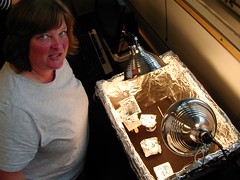

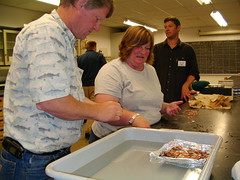
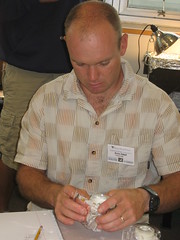
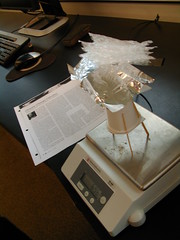
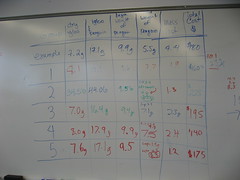
DYF Teacher Institute II Tuesday | Design Your Future said,
August 4, 2009 at 10:37 pm
[…] hour talking about Minute Papers from the previous day. Our topics included Thursday project ideas, the limits of mathematics education, and […]
Becca said,
August 10, 2009 at 3:16 pm
Played with the Save the Penguins activity at home-really fun, I have pictures, but don’t know how to post them here.
Lonny said,
August 10, 2009 at 3:46 pm
Hi Becca,
Are you up for writing a little blog about your experience making it at home? If so, I can give you a login and you can write a blog article… otherwise you can send me the photos (but I like the Becca bloggin idea better). 🙂